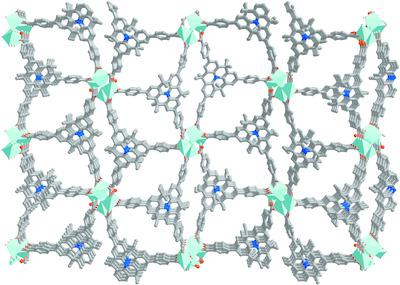当前位置:
X-MOL 学术
›
Acta Cryst. C
›
论文详情
Our official English website, www.x-mol.net, welcomes your
feedback! (Note: you will need to create a separate account there.)
Syntheses and structures of two novel fluorescent metal-organic frameworks generated from a tridentate donor-acceptor motif ligand.
Acta Crystallographica Section C ( IF 0.7 ) Pub Date : 2020-05-22 , DOI: 10.1107/s2053229620006488 Yong Jin Zhao 1 , Jian Ping Ma 1 , Jianzhong Fan 2 , Yan Geng 1 , Yu Bin Dong 1
Acta Crystallographica Section C ( IF 0.7 ) Pub Date : 2020-05-22 , DOI: 10.1107/s2053229620006488 Yong Jin Zhao 1 , Jian Ping Ma 1 , Jianzhong Fan 2 , Yan Geng 1 , Yu Bin Dong 1
Affiliation

|
The tridentate organic ligand 4,4′,4′′‐(4,4,8,8,12,12‐hexamethyl‐8,12‐dihydro‐4H‐benzo[9,1]quinolizino[3,4,5,6,7‐defg]acridine‐2,6,10‐triyl)tribenzoic acid (H3L) has been synthesized (as the methanol 1.25‐solvate, C48H39NO6·1.25CH3OH). As a donor–acceptor motif molecule, H3L possess strong intramolecular charge transfer (ICT) fluorescence. Through hydrogen bonds, H3L molecules construct a two‐dimensional (2D) network, which pack together into three‐dimensional (3D) networks with an ABC stacking pattern in the crystalline state. Based on H3L and M(NO3)2 salts (M = Cd and Zn) under solvothermal conditions, two metal–organic frameworks (MOFs), namely, catena‐poly[[triaquacadmium(II)]‐μ‐10‐(4‐carboxyphenyl)‐4,4′‐(4,4,8,8,12,12‐hexamethyl‐8,12‐dihydro‐4H‐benzo[9,1]quinolizino[3,4,5,6,7‐defg]acridine‐2,6‐diyl)dibenzoato], [Cd(C48H37NO6)(H2O)3]n, I, and poly[[μ3‐4,4′,4′′‐(4,4,8,8,12,12‐hexamethyl‐8,12‐dihydro‐4H‐benzo[9,1]quinolizino[3,4,5,6,7‐defg]acridine‐2,6,10‐triyl)tribenzoato](μ3‐hydroxido)zinc(II)], [Zn2(C48H36NO6)(OH)]n, II, were synthesized. Single‐crystal analysis revealed that both MOFs adopt a 3D structure. In I, partly deprotonated HL2− behaves as a bidentate ligand to link a CdII ion to form a one‐dimensional chain. In the solid state of I, the existence of weak interactions, such as O—H…O hydrogen bonds and π–π interactions, plays an essential role in aligning 2D nets and 3D networks with AB packing patterns for I. The deprotonated ligand L3− in II is utilized as a tridentate building block to bind ZnII ions to construct 3D networks, where unusual Zn4O14 clusters act as connection nodes. As a donor–acceptor molecule, H3L exhibits fluorescence with a photoluminescence quantum yield (PLQY) of 70% in the solid state. In comparison, the PL of both MOFs is red‐shifted with even higher PLQYs of 79 and 85% for I and II, respectively.
中文翻译:

由三齿供体-受体基序配体产生的两个新型荧光金属-有机骨架的合成和结构。
三齿有机配体4,4',4'' - (4,4,8,8,12,12六甲基-8,12-二氢-4- ħ -苯并[9,1] quinolizino [3,4,5 ,6,7- DEFG ]吖啶-2,6,10-三基)三苯甲酸(ħ 3大号)已被合成(如甲醇1.25溶剂化物,C 48 ħ 39 NO 6 ·1.25CH 3 OH)。作为供体-受体基序分子,H 3 L具有强大的分子内电荷转移(ICT)荧光。通过氢键,H 3 L分子构成一个二维(2D)网络,该网络与ABC一起组装成三维(3D)网络处于结晶状态的堆积模式。基于ħ 3大号和中号(NO 3)2克盐(中号溶剂热的条件下,两个金属-有机骨架(MOF)下= Cd和Zn),即连锁-聚[[triaquacadmium(II)] - μ-10- (4-羧基苯基)-4,4'-(4,4,8,8,12,12-六甲基-8,12-二氢-4 H-苯并[9,1]喹啉[3,4,5,6 ,7- DEFG ]吖啶-2,6-二基)dibenzoato],[CD(C 48 ħ 37 NO 6)(H 2 O)3 ] ñ,我和聚[[μ 3‐4,4′,4′′‐(4,4,8,8,12,12-六甲基‐8,12‐二氢‐4 H‐苯并[9,1]喹啉[3,4,5,6,合成了7 defg ]啶-2,6,10-三基三苯并[] 3 [-羟基氧化]锌(II),[Zn 2(C 48 H 36 NO 6)(OH)] n,II。单晶分析表明两个MOF均采用3D结构。在I中,部分去质子化的HL 2-充当双齿配体,将Cd II离子连接形成一维链。在我的固态,弱相互作用(例如OH ... O氢键和π-π相互作用)的存在在将2D网络和3D网络与I的AB堆积模式对齐方面起着至关重要的作用。去质子化的配体大号3-在II被用作三齿积木结合的Zn II离子以构建3D网络中,不寻常的Zn 4 ö 14簇用作连接节点。作为供体-受体分子,H 3 L在固态下具有70%的光致发光量子产率(PLQY)的荧光。相比之下,两个MOF的PL都发生了红移,其中I的PLQY更高,分别为79和85%。和II。
更新日期:2020-05-22
中文翻译:

由三齿供体-受体基序配体产生的两个新型荧光金属-有机骨架的合成和结构。
三齿有机配体4,4',4'' - (4,4,8,8,12,12六甲基-8,12-二氢-4- ħ -苯并[9,1] quinolizino [3,4,5 ,6,7- DEFG ]吖啶-2,6,10-三基)三苯甲酸(ħ 3大号)已被合成(如甲醇1.25溶剂化物,C 48 ħ 39 NO 6 ·1.25CH 3 OH)。作为供体-受体基序分子,H 3 L具有强大的分子内电荷转移(ICT)荧光。通过氢键,H 3 L分子构成一个二维(2D)网络,该网络与ABC一起组装成三维(3D)网络处于结晶状态的堆积模式。基于ħ 3大号和中号(NO 3)2克盐(中号溶剂热的条件下,两个金属-有机骨架(MOF)下= Cd和Zn),即连锁-聚[[triaquacadmium(II)] - μ-10- (4-羧基苯基)-4,4'-(4,4,8,8,12,12-六甲基-8,12-二氢-4 H-苯并[9,1]喹啉[3,4,5,6 ,7- DEFG ]吖啶-2,6-二基)dibenzoato],[CD(C 48 ħ 37 NO 6)(H 2 O)3 ] ñ,我和聚[[μ 3‐4,4′,4′′‐(4,4,8,8,12,12-六甲基‐8,12‐二氢‐4 H‐苯并[9,1]喹啉[3,4,5,6,合成了7 defg ]啶-2,6,10-三基三苯并[] 3 [-羟基氧化]锌(II),[Zn 2(C 48 H 36 NO 6)(OH)] n,II。单晶分析表明两个MOF均采用3D结构。在I中,部分去质子化的HL 2-充当双齿配体,将Cd II离子连接形成一维链。在我的固态,弱相互作用(例如OH ... O氢键和π-π相互作用)的存在在将2D网络和3D网络与I的AB堆积模式对齐方面起着至关重要的作用。去质子化的配体大号3-在II被用作三齿积木结合的Zn II离子以构建3D网络中,不寻常的Zn 4 ö 14簇用作连接节点。作为供体-受体分子,H 3 L在固态下具有70%的光致发光量子产率(PLQY)的荧光。相比之下,两个MOF的PL都发生了红移,其中I的PLQY更高,分别为79和85%。和II。











































 京公网安备 11010802027423号
京公网安备 11010802027423号